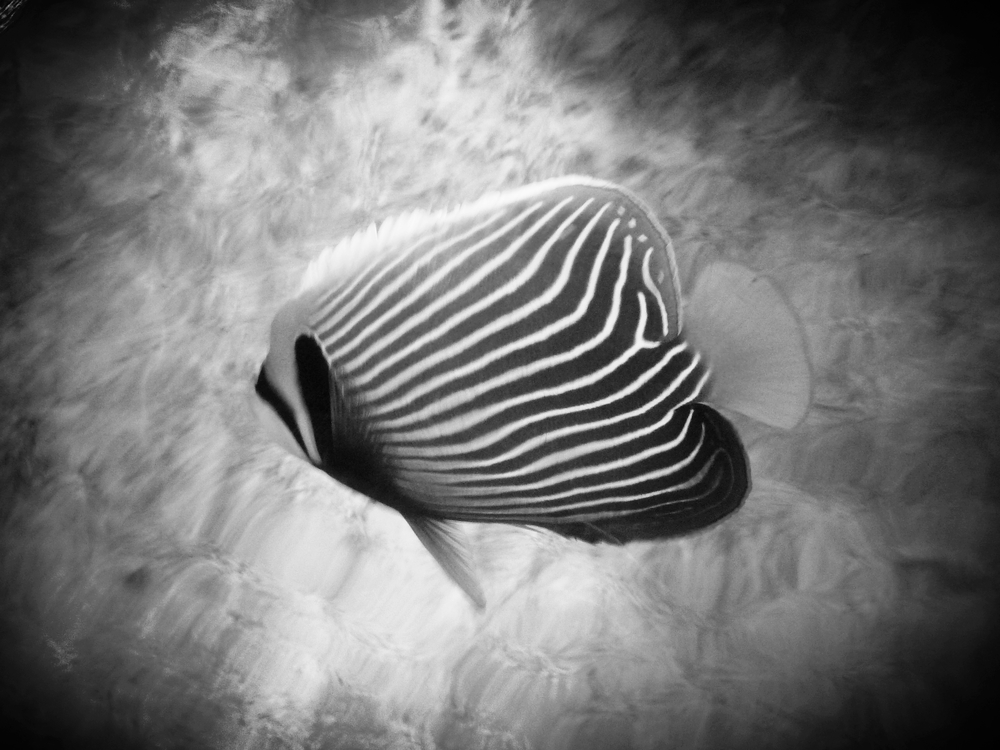
As the gate swings open, four old dogs play in the yard, noses to the dirt, weaving and swerving around boats, an aging tractor and a maze of white styrofoam boxes with practiced ease. Under the hot Wai’anae sun, dive tanks stand in haphazard formation like miniature gray soldiers with “Kaiohi” stamped uniformly across them. Kaiohi Tropical Fish owner and diver Rufus Kimura emerges from under his tented aquarium area and, for a second, it is easy to forget that this man is at the forefront of a very small and quite unheard of underwater revolution.
Kimura is stocky, with dark hair shaved short, and asian features that make it hard to decide if he’s 25 or 40 years old. He wears a long-sleeved shirt, yet, he seems perfectly comfortable in the midday heat. Kimura exudes calm and competence, whether talking about fish species “Oh, this is an Arathron meleagris,” he says, referring to a fish resembling an old yellow papaya, or chopping basil he grew himself in his backyard garden (Turns out he also grows chili peppers, lemon grass and kaffir limes.) He is also one of a very select group of non-military divers that use the newest technology to explore depths of 300 to 500 feet known as “the Twilight Zone.”
“The Twilight Zone,” as a region, has been largely unexplored for a myriad of reasons. For one, Kimura explains, “submersibles are really expensive and if they’re going to send one down it will typically be going to its maximum depth around 2,000 ft. They’re not going to waste money sending it down to 300 feet.” The second reason is that the mixture of gasses in normal scuba tanks turns toxic at a certain pressure (usually around 250 feet). Kimura experienced this first-hand about five years ago.
“The first time I can remember diving was with my dad when I was nine years old,” said Kimura, now standing beside own boat 23 years later. “I was certified by the time I was 11.”
“Honestly, I got bored diving. At the same depth you see the same things, the same species. We
kept trying to push it, do deeper dives and I got bent really badly,” said Kimura while candidly adding, “I didn’t have health insurance at the time and I didn’t want to pay to go to the hospital. So I just took a couple of vicodin and had to ride it out.” It was at this point he knew he needed to invest in the right equipment if he wanted to continue going deeper.
Ready to descend for a rebreather dive, Kimura wears more than 100 pounds of gear. His motorized scooter is picture in the background. Kimura and his partner collected fish at 384 feet this day. He invested in two devices known as rebreathers. Although rebreathers have been used for decades by Navy frogmen, they have only recently become commercially available. The rebreather works by absorbing the exhaled carbon dioxide and injecting a small amount of oxygen, thereby recirculating a diver’s exhalation. More importantly, there is more helium and less oxygen and nitrogen in the mixture, which decreases the risk of toxicity.
“I haven’t had any problems since then,” but he adds laughing, “I always double-check my headlamp and then my backup light, and then my backup to my backup light. It’s hard to change batteries at 400 feet.”
Kimura, in addition to diving, is a full-time search and rescue firefighter and a contributing writer for Hana Hou magazine. Yet, when asked about his rebreather dive experiences over the last four years, he struggles to draw a parallel that a regular person could understand.
“It’s crazy. At 60 feet red light is filtered out and you bleed green. At 300 feet it’s like dusk, and the water temperature drops about 20 degrees. At 500 feet it’s just plain weird. It’s like being in the ocean in the middle of the night seeing all these fish you don’t see anywhere else. Plus, you feel kind of drunk,” said Kimura. Technically named nitrogen narcosis, breathing compressed gasses has the inadvertent effect of causing an altered mental state similar to alcohol intoxication. It’s at these depths that Kimura has made a name for himself by collecting extremely rare fish. His most recent find were two Roa excelsea butterflies; it was the first time this specie was ever collected alive.
Besides the inherent risk involved, one of the only drawbacks of dives in excess of 400 feet is the long decompression time necessary to avoid the bends (an informal name for the formation of nitrogen bubbles in the body when pressure decreases). In order to avoid this, a diver must ascend slowly. On a dive where he spends eight minutes at the bottom, decompression lasts five hours. The majority of it is spent at 30 feet, where the surface seems just out of reach.
“You have a lot of time to think..or collect shells,” said Kimura laughing as his miniature pony Jack races around trying to bite the dogs, “I like to think it taught me patience.”
comments +